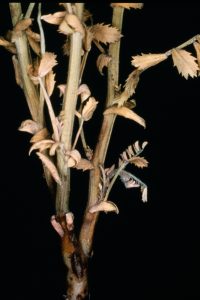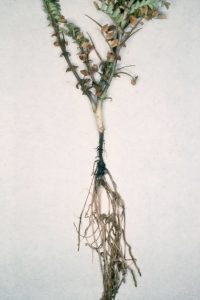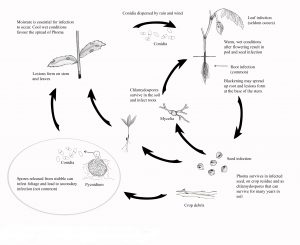Phoma blight, caused by the fungus Phoma medicaginis var. pinodella, has the potential to be a serious disease of chickpeas. The disease has only caused serious crop losses in seasons with above average winter rainfall.
What to Look For
Seed-borne infection often results in black-brown discolouration of the root near the point of seed attachment. Blackening may spread up the root and cause lesions at the base of the stem.
Initial above ground symptoms are small, dark tan coloured, irregular flecks on leaves, stems and pods. The flecks on leaves enlarge to lesions and the surrounding tissue yellows. Within the lesions numerous pinhead-sized black fruiting bodies of the fungus develop. Similar but more elongated lesions form on the stem.
Black lesions may completely girdle the base of the stem and roots where infection is severe. Pod lesions are sunken, with pale centres and dark margins and may be covered by small black spots. The fungus may penetrate the pod and infect developing seeds. Badly affected plants may be totally defoliated when infected leaflets senesce and fall.
Disease Cycle
The fungus can survive on infected seed, in soil and on crop residue. Outbreaks of the disease are most likely to be in those paddocks with a recent history of chickpea or field pea. Infected seeds may give rise to infected plants, or spores in the soil may infect the roots of young plants. Spores produced on infected crop residues may also be carried by wind into the new season’s crop. Infection can occur at any stage of plant growth provided conditions are favourable. Moisture is essential for infection to occur.
During wet weather, the disease may spread further when fungal spores are carried by wind and rain-splash onto neighbouring plants. Severe pod infection results in reduced yield and infected seed. However, grain quality (i.e. appearance and grain size) is not affected.
Management
Clean Seed
The use of disease free seed and crop rotation will help prevent the establishment and build-up of this disease.
Crop Rotation
Where chickpeas have been badly infected, a two-year break from host crops will minimise the disease risk. Crops which host phoma include field pea, chickpea, faba bean, lupin, lentil, vetch and legume pasture species. Cereal and oilseed crops will provide a good disease break.
Chemical Control
Seed-borne disease infection can sometimes be controlled with fungicide seed dressings. No fungicides are known to manage this disease in crop.





